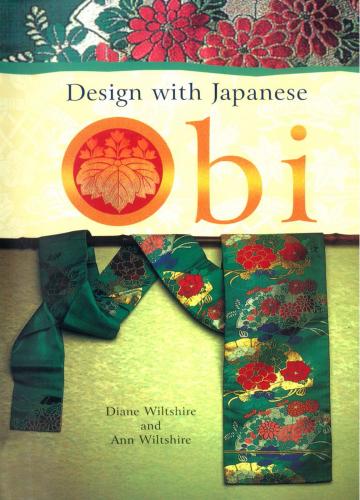(Frontispiece) An ornate maru obi is strewn over a soft blanket of snow.
Published by Tuttle Publishing, an imprint of Peripius Editions (HK) Ltd.
© 1997 Charles E. Tuttle Publishing Company, Inc.
All rights reserved.
LCC Card No. 96-61005
ISBN: 978-1-4629-0796-0 (ebook)
First paperback edition, 2002
15 14 13 12 11 10 9 8 7 6 5 4
Printed in Singapore
Contents
| 7 | Acknowledgments |
| 9 | Introduction |
| 13 | Table Art |
| 23 | Dining Accents |
| 33 | Framing Highlights |
| 43 | Draping Effects |
| 51 | Hanging Displays |
| 57 | Furniture Complements |
| 75 | Fabric Coverings |
| Appendixes: | |
| 1. History of the Obi 89 | |
| 2. Weaves, Dyes, Stitches 91 | |
| 3. Types of Obi 94 |
Acknowledgments
In loving memory of
our mother and grandmother,
Linda Brumfield Bilbo
Special thanks are in order to the many people whose advice and support enabled us to write a book about decorating with the Japanese obi. At Tuttle, our editor provided the initial enthusiasm for the project and then proceeded to implement and refine our vision. Our Australian photographer, Vincent Long, worked tirelessly in the U.S. and Tokyo to give us the shots that we needed. Thanks also to Michael Barrett and Michael Guttuso for providing us with additional photographs and styling. In Tokyo, Barbara Knode introduced us to the design genius of Shoji Osugi and we spent a delightful day together photo-graphing his exquisite obi creations. Naomi Iwasaki Hoff graciously provided us with her original obi pillows and teaboxes for use in the book. A big thank you goes to Martha Widman for her fine sewing skills; Martha has relined or repaired hundreds of obi for us over the years and her handiwork is featured in many of the obi pillow designs shown in this book. We also appreciate the hours that Noriko Faust spent translating the tiny kanji (Chinese characters) on the back of obi for us. In Washington D.C., the staff at the Textile Museum was invaluable in contributing to our research. Additional information was obtained by consulting with the many obi experts in Japan who patiently answered our endless questions. We especially want to thank Gallery Kawano and Toshiko Yamazaki, Shigeko Ikeda, Seizaburo Ando at Odawara Shoten, Yukiko Matsuzaki, Yoshiko Chida, Ryoko Masakane, Naiko Funakoshi, Aiko Sasaki, Setsuko Miura, and the Nishijin-ori Kai in Kyoto. And to those friends who so generously opened their homes to us for photographing the obi in all manner of settings, a very special thank you!
In Japan
Sabine and Urs Schmid, Kathryn and Curtis Baker, Barbara and Don Knode, Geeta and Krishen Mehta, Ellen and David Dutkowsky, Ivan Woodhouse, Naomi Iwasaki Hoff
In the U.S.
Connie and Steve Lanzl, Loralie and Lee Parks, Sarah and Phil Nelson, Joanne and Philip Horton, Susan and Alan Kasper, Gerald Falls, Lee and Dick Nance, Carol O'Donnell Miscio at Celestial Connections, Richard Santos
Introduction
Using Obi as a Decorative Accessory
Over the past few decades the Japanese kimono sash, or obi, has gained popularity as a home decorating accessory. The exquisite silk fabric, made into intricate patterns with stunning colors, makes the obi desirable as an accent in any room. Any of the obi styles mentioned in this book can be turned into objects of art for the home. Unlike the rules of fashion that dictate which kimono are worn with which obi, there are no restrictions when it comes to decorating with the obi. From contemporary to traditional interiors, the draping of an obi in a room can soften hard lines and add color to an otherwise drab area.
Although the most popular use for the obi with Westerners is as a table runner, it can also be used as a wall hanging or sculpture, or as an accent on furniture such as chests, pianos, and mantels. Obi of varying lengths can be folded, knotted, or tied with tassels to achieve the desired effect. Remnants of silk obi can be resewn into pillows and bedspreads, even showcased in picture frames.
Initially the maru obi was favored as an accessory due to its length of up to 4 m (4½ yd.) and width usually of 30 cm (12 in.). Maru obi also tend to be made of the finest brocade and are more expensive than other styles. Fukuro obi, while sewn differently, are very similar to maru obi in length and width. As fukuro obi were introduced in the 1920s in Japan, the very oldest obi are almost always of the maru style.
When selecting either a maru or fukuro obi, take time to unfold the obi and check the full length for any damaged spots. Also, look carefully at the design, as some obi may be missing part of the pattern. You may find, for example, that the flowers in a pattern are not fully colored on one section. This may have been an economic decision and not an oversight as only certain sections of the obi are visible when worn with kimono. However for someone who plans to display the full length, an uneven or unfinished pattern could present a problem.
Check the reverse side of the obi as well. Many obi are reversible, with a different but equally fantastic design on the back. It may also be a less expensive piece of fabric that totally clashes with the front. Sometimes the lining is plain
